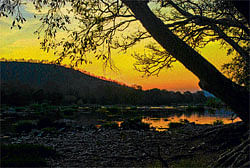B V Prakash treks up Basavana Betta in the Cauvery Wildlife Sanctuary, and offers us views of the forest, the wildlife and the water sources there.

The vegetation and topography of Karnataka is indeed diverse. While the Western Ghat ranges extend along the west coast, the hill ranges of the south east form parts of the Nilgiri Biosphere. Between the two are a spread of lesser hills and valleys along the course of the river Cauvery.
The jungles have dry deciduous trees and scrub forest. A good variety of wildlife exists here and forest area extending over 526 sq. km was designated the Cauvery Wildlife Sanctuary in 1987. A proposal to expand the sanctuary by another 500 sq. km is in the offing. More importantly, this is the main elephant movement area which was why the Ministry of Environment and Forests earmarked the sanctuary as a ‘Key Elephant Habitat’ under the Project Elephant in 1992 so that some of the issues like conservation of elephants and their habitat, measures to mitigate man-animal conflict, protection of pachyderms from poachers, etc could be addressed. The sanctuary supports other forms of fauna also like the leopard , tiger, deer and wild boar besides scores of reptiles and birds.
The River Cauvery is home to large mahseer fish prompting many fishing camps to spring up. With the river too forming part of the sanctuary, fishing activities have since been banned. The hills, the forest and the wildlife of the sanctuary surely beckon naturalists and adventurers. To assist visitors to do that, the forest department has come up with the novel concept of organised trekking under the name ‘Mystery Trails’. Run by the Eco development committee involving the local tribal community who act as guides and benefit economically, the designated jungle trails can be taken up with due permission. You will be escorted by a guide during the trek.
On a recent visit, we chose one such trail to climb the moderately high Basavana Betta in the sanctuary. Our journey from Bangalore was broken at Kanakapura to visit the Range forest office for the formalities. The RFO Sunitha Bai promptly granted permission and arranged for our stay at the forest rest house.
Starting point
Reaching Bheemeshwari nature camp on the banks of Cauvery by late afternoon, we relaxed for the day. The evening saw a few visitors; a sounder of wild boars and spotted deer while the monkeys munched on the fruits of tamarind trees. At the fall of night we could hear the wailing howls of jackals.
The jungle walk began before the sun turned fiercer. Boraiah, our guide, led us through the game road adjacent to an anti-poaching camp. Even though, summer was yet to set in, it was sultry. The jungle had dried up already and patches of grass had burnt out. Not too pleasing. But this is part of the lifecycle of jungles. And in a way it was differently nice. The sparseness of the forest also offers good visibility of wildlife. Trudging slowly, we came to a watch tower on a ridge overlooking the valley and the river. The path led to a place called Bennane with a small tank on the verge of drying. This is the last source of water for the wildlife, right from langurs to elephants, remarked our guide. And when it dries up completely, the animals head down to the river below.
The rest of the path went up steeply. Despite being a game road, the gravel and loose soil offered little resistance to our feet making the climb more exhaustive. After 11km, we climbed a rock patch and reached a plateau as a frightened sambar deer scampered away.
We followed the path to the peak of Basavana Betta rising to 3,700 ft. The lone guest house here was built by the erstwhile Maharajas of Mysore who used to come here on horseback to relax. Now the place is abandoned without even the most basic of facilities to stay. The views from the top are enchanting with the long stretch of the Cauvery flowing amidst the valley of dry forests and rocky outcrops.
Our descent was easy but thrilling as the guide sensed elephants in the vicinity.
These guides have an uncanny ability to smell the presence of wild animals. This time it wasn’t the smell but the snapping of twigs and the rustle of the leaves. It is for this reason that going by ourselves in a forest is not allowed. We silently retraced our way back and took a detour over rocks and through thorny bushes. Doing that extra mile, the day-long trek of nearly 25 km culminated at Muthathi by twilight.
Getting there:
Bheemeshwari nature camp is 95 km from Bangalore and can be reached via Kanakapura (57 km), Sathanur and Muthathi. Forest rest houses are available for stay at Bheemeshwari and Muthathi. The trek of 22 km is quite hard.
Permission can be obtained at Range office, Kanakapura